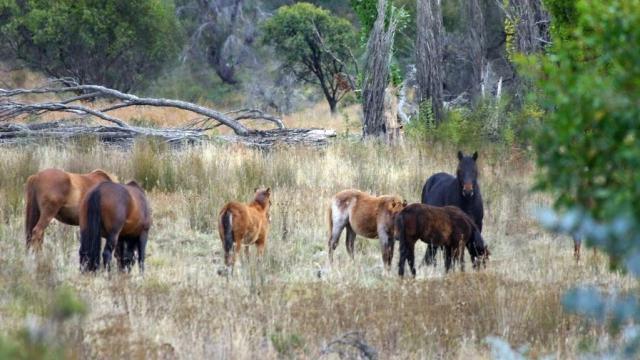A proposed plan to cull upwards of 10,000 feral horses, while still retaining a smaller population, won’t prevent ongoing damage to a sensitive Australian park, according to a concerned group of scientists.
Kosciuszko National Park in New South Wales is home to an estimated 14,380 wild horses. The large herbivores, with their hard hooves, trample the delicate vegetation and disturb the landscape. For this is kangaroo and wallaby country — not horse country — so the local ecosystem suffers as a result.
As they roam free, the thousands of feral horses, known as brumbies to Australians, send cascading waves of despair through the ecosystem, threatening stocky galaxias fish, alpine tree frogs, Riek’s crayfish, broad-toothed rats, among many other native species. Should nothing be done about the brumbies, their numbers could reach upwards of 20,000 in the park by 2022, according to an open letter sent to NSW environment minister Matt Kean late last month.
The letter, penned by 15 scientists and signed by 69 supportive researchers and scientific societies, argues that a newly revised government plan to cull 10,000 wild horses doesn’t go far enough, as it would still allow 3,000 horses to inhabit one-third of the park. These horses would continue to threaten endangered species and the local ecology as a whole, the scientists argue. Kosciuszko Park “cannot begin to recover from drought, extensive bushfires and overgrazing if, as currently proposed, 3,000 feral horses remain,” according to the letter, written on behalf of the Australian Academy of Science.
The plan, disclosed in September, was prepared by NSW National Parks & Wildlife Service, and it’s a revision to a similar strategy proposed five years ago. The government is keen to protect Kosciuszko, as it’s among Australia’s largest alpine parks. Most horses will be shot from the ground, but some will be relocated to other areas.
The decision to retain so many horses has to do with the animals’ perceived heritage value, which stems from “pioneering history and pastoralism,” “traditional mountain practices associated with stock management,” “brumby running and horse trapping,” and also “legends, stories and myths of the Snowy Mountains,” according to the plan. Also, specific types of wild horses are deemed to have heritage value, including the Kiandra greys and the McDonald Silver and Taffy horses. As the plan states, retention areas comprising 32% of the park “ensures that wild horse heritage values are protected, and other environmental values of the park are maintained.”
The 2016 draft management plan called for an eventual population of roughly 600 horses, but as the Sydney Morning Herald reported last month, the government seems to have been swayed by “community groups eager to promote the horses’ heritage value.”
The authors of the open letter are questioning the need to retain so many wild horses in the park, especially given that conservationists will now have to continually kill these horses to keep the growing population in check.
To protect native plants, animals, and the local ecosystem from the brumbies, the group of scientists is asking the government to “reduce feral horse numbers rapidly to well below the preliminary target of 3,000 by using all available methods that are effective,” and to do so in accordance with animal welfare standards. In addition, the scientists want the entirety of Kosciuszko National Park to be protected from feral horses, and not just a third. And finally, they’re asking the government to rescind the Kosciuszko Wild Horse Heritage Act 2018, “which is a legal impediment to effective evidence-based national park management, and is completely at odds to the National Parks and Wildlife Act 1974.”
This seems like a no-brainer to me, and I’m fully behind the scientists. It’s regrettable that so many horses will have to be killed, but Australians need to do right by the native environment and not get distracted by all that hokey talk about cultural heritage. All this supposed heritage won’t amount to crap if Australia’s natural heritage gets wiped out as a result.
